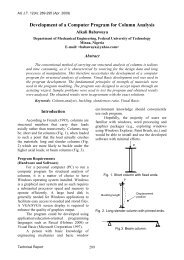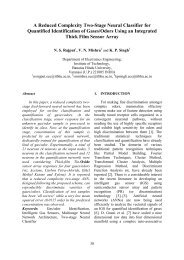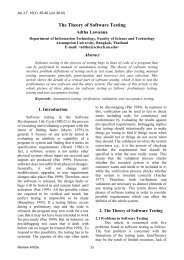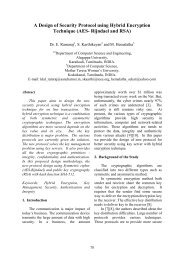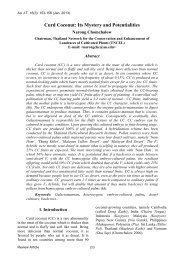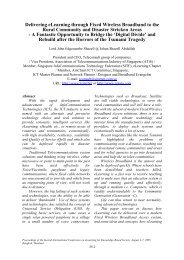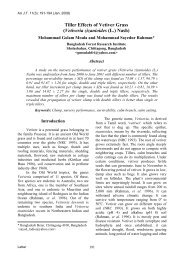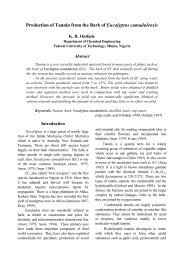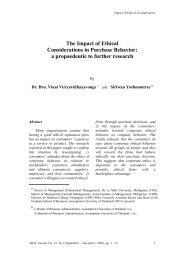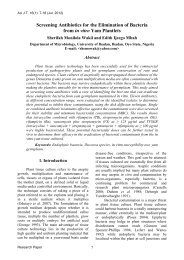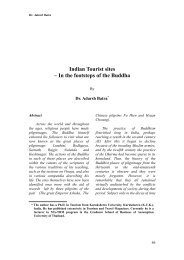Environmental Pollution and Public health - AU Journal
Environmental Pollution and Public health - AU Journal
Environmental Pollution and Public health - AU Journal
You also want an ePaper? Increase the reach of your titles
YUMPU automatically turns print PDFs into web optimized ePapers that Google loves.
<strong>AU</strong> J.T. 10(1): 29-37 (Jul. 2006)<br />
<strong>Environmental</strong> <strong>Pollution</strong> -Especially Air <strong>Pollution</strong> - <strong>and</strong> <strong>Public</strong> Health<br />
Sr. Little Flower<br />
Department of General Education, Faculty of Arts, Assumption University<br />
Bangkok, Thail<strong>and</strong><br />
Abstract<br />
<strong>Pollution</strong> is a necessary evil of all development. It is an undesirable change in the<br />
physical, chemical or biological characteristics of air, water <strong>and</strong> soil that may harmfully<br />
affect the life or create a potential <strong>health</strong> hazard of any living organism <strong>and</strong> in<br />
particular for man. Industrialized countries of the world release in to the atmosphere<br />
pesticides, detergents, plastics, solvents, fuels, paints, dyes, food additives etc. are some<br />
of the examples. Besides these there are a number of industrial effluents emissions of<br />
poisonous gases in the atmosphere. Mining activities also added to this problem,<br />
particularly as solid waste. The unfavorable conditions created by man himself<br />
threatened the survival not only of man himself but also other living organisms.<br />
Keywords: Pollutant, poisonous gases, industrial effluents, atmosphere, global<br />
warming, environment, green house effect, natural resource, chemicals.<br />
Environment on 14 June 1972 in Stockholm,<br />
Introduction<br />
Sweden, the late Prime Minister of India, Indira<br />
The ‘mad rat race’ among nations over<br />
the globe for development jeopardized the<br />
heath of man itself. Progress in agriculture <strong>and</strong><br />
industry is taken a general criterion of<br />
development of any country. This craze<br />
resulted into unlimited exploitation of every bit<br />
of natural resource. Such activities of man had<br />
adverse effect on all forms of living organisms<br />
in the biosphere. Unlimited exploitation of<br />
nature by man disturbed the ecological balance<br />
between living <strong>and</strong> non living component of<br />
the biosphere. Due to lack of development of a<br />
culture of pollution control, there has resulted a<br />
heavy backlog of gaseous, liquid <strong>and</strong> solid<br />
pollution in all over the world. It is to be<br />
cleaned. Thus pollution control is a recent<br />
environmental concern.<br />
The developed countries have been in a<br />
mad race to exploit every bit of natural<br />
resource to convert them into goods for their<br />
comfort, <strong>and</strong> to export them to needy<br />
developing world. In doing so, the<br />
industrialized countries dump lot of materials<br />
in their environment which become polluted.<br />
In a way, pollution has been ‘exported’<br />
to developing countries. UN Conference on<br />
G<strong>and</strong>hi had said, “Modern man must re-establish<br />
an unbroken link with nature <strong>and</strong> with life. He<br />
must again learn to invoke the energy for growing<br />
things <strong>and</strong> to recognize, as did the ancients<br />
in India centuries ago, that one can take from<br />
the earth <strong>and</strong> the atmosphere only so much as<br />
one put back in the them” (Sharma1998).<br />
<strong>Pollution</strong> is an undesirable change in the<br />
physical, chemical or biological characteristics<br />
of air, water <strong>and</strong> soil that may harmfully affect<br />
the life or create a potential <strong>health</strong> hazard of<br />
any living organism <strong>and</strong> in particular for man.<br />
What are pollutants? Any substance that<br />
caused pollution is called a pollutant. A<br />
pollutant may thus include any chemical or<br />
agrochemical substance, biotic component or<br />
its products or physical factor (heat) that is<br />
released by man into the environment, that may<br />
have adverse harmful or unpleasant effects. A<br />
pollutant has also been defined as any solid,<br />
liquid, or gaseous substance present in such<br />
concentration as may be or tend to be injurious<br />
to the environment”. Pollutants are the<br />
residues of things we make, use <strong>and</strong> throw<br />
away. There are many sources of such<br />
pollutants. The lake <strong>and</strong> rivers are polluted by<br />
wastes from chemical <strong>and</strong> other factories,
waste from human <strong>and</strong> the air by gases of<br />
automobile exhausts, industries, thermal power<br />
plants, etc.<br />
Air <strong>Pollution</strong><br />
The atmosphere is an insulating blanket<br />
around the earth. It is source of essential gases,<br />
maintains a narrow difference of day <strong>and</strong> night<br />
temperatures <strong>and</strong> provides a medium for long<br />
distance radio communication. It also acts as<br />
shield around the earth against lethal UV<br />
radiations. With out atmosphere, there will be<br />
no lightening, no wind, no clouds, no rains, no<br />
snow <strong>and</strong> no fire.<br />
Sources <strong>and</strong> Pollutants<br />
Air pollution results mainly from<br />
gaseous emissions of industry thermal power<br />
stations, automobiles, domestic combustions,<br />
smoke from the fire etc. From the different<br />
sources of air pollution, a variety of pollutants<br />
are released in to atmosphere. The main air<br />
pollutants emitted from these different sources<br />
<strong>and</strong> how these pollutants affect the human <strong>and</strong><br />
other living organisms on the planet are<br />
described:<br />
1. Carbon compounds: These are CO 2 <strong>and</strong><br />
Co, the former is released by complete<br />
combustion of fossil fuels, <strong>and</strong> the latter<br />
by automobile exhausts.<br />
2. Sulfur compounds: These include SO 2 ,<br />
HS <strong>and</strong> H 2 SO 4 mostly released by fossilfuel-based<br />
power generating plants,<br />
thermal plants, <strong>and</strong> refineries.<br />
3. Nitrogen oxides: These include NO, NO 2 ,<br />
HNO 3 mostly released by automobiles,<br />
power plants <strong>and</strong> industries.<br />
4. Ozone: Its level may rise in astrosphere<br />
due to human activities.<br />
5. Fluorides: These come from industries,<br />
insecticides spray etc.<br />
6. Hydrocarbons: These are chiefly benzene,<br />
benz pyrene etc which are released by<br />
automobiles <strong>and</strong> industries.<br />
7. Metals: These include lead, nickel arsenic,<br />
beryllium, tin, vanadium, titanium,<br />
cadmium, etc. present in the air as solid<br />
particles or liquid droplets or gases. They<br />
are produced mostly by metallurgical<br />
processes, automobiles, sea spray, etc.<br />
8. Photochemical products: These are<br />
photochemical smog, PAN, PB 2 N, etc.<br />
released by automobiles.<br />
9. Particulate matter: These are fly ash,<br />
dust, grit <strong>and</strong> other suspended particulate<br />
matter released from power plants <strong>and</strong><br />
industries (stone crushers)<br />
10. Biological particulate matters: Bacterial<br />
cells, fungal spores <strong>and</strong> pollens in air.<br />
11. Toxicants other than heavy metals: These<br />
are complex chemical substances released<br />
during manufacture of other goods.<br />
Carbon Compounds<br />
The two important pollutants are CO 2 <strong>and</strong> CO.<br />
Carbon Dioxide (CO 2 ): Major amount of<br />
CO 2 is released in the atmosphere from burning<br />
of fossil fuel (coal, oil, etc.) for domestic<br />
cooking, heating, etc. <strong>and</strong> the fuel consumed in<br />
furnaces of power plants, industries, hot mix<br />
plants, etc. Another reason is the destruction of<br />
the forest in the tropical regions of the world.<br />
These ecosystems are efficient in removing<br />
CO 2 <strong>and</strong> storing the C atoms in the structure of<br />
the plant. From fossil fuels alone more than 18<br />
x 10 2 ton of CO 2 are being released into<br />
atmosphere each year. This gas is also emitted<br />
during volcanic eruptions. An increase in CO 2<br />
concentration in atmosphere may result into<br />
disastrous effects as green house effect.<br />
Greenhouse Effect <strong>and</strong> Global Warming:<br />
Since CO 2 is confined exclusively to the<br />
troposphere, its higher concentration may act a<br />
serious pollutant. Under normal conditions the<br />
temperature at the surface of the earth is<br />
maintained by the energy balance of the sun<br />
rays that strike the planet <strong>and</strong> heat that is<br />
reradiated back in to space. However, when<br />
there is an increase in CO 2 concentration, the<br />
thick layer of this gas prevents the heat from<br />
being reradiated out. This thick CO 2 layer thus<br />
functions like the glass panels of a greenhouse<br />
(or the glass windows of a motorcar), allowing<br />
the sunlight to filter through but preventing the<br />
heat from being radiated in outer space. This is<br />
the so-called Greenhouse Effect.<br />
30
Thus, most heat is absorbed by CO 2 layer<br />
<strong>and</strong> water vapor in the atmosphere, which adds<br />
to the heat that is already present. The net<br />
result is the heating up of the earth’s<br />
atmosphere. Thus increasing CO 2 levels tends<br />
to warm the air in the lower layers of<br />
atmosphere on a global scale. Nearly 100 years<br />
age the CO 2 level was 275 ppm. Today it is<br />
350 ppm <strong>and</strong> by the year 2035 <strong>and</strong> 2040 it is<br />
expected to reach 450 ppm. CO 2 increases the<br />
earth temperature by 50% while CFCs are<br />
responsible for another 20% increase. There<br />
are enough (CFCs up there to last 120 years)<br />
(Sharma 1999).<br />
The excess CO 2 to some extent is<br />
absorbed by the oceans. But with the<br />
industrialization of the west <strong>and</strong> increased<br />
consumption of energy, CO 2 was released in to<br />
the atmosphere at a faster rate than the capacity<br />
of oceans to absorb it. Thus its concentration<br />
increased. There are other gases also which<br />
contributed to green house effect. These are<br />
SO 2 , NOx, CFCs discharged by industry <strong>and</strong><br />
agriculture. CFCs were widely used as<br />
refrigerant gases in refrigeration’s <strong>and</strong> air<br />
conditioners. There is a strong correlation<br />
between the increase in temperature <strong>and</strong> the<br />
amount of green house gases.<br />
According to one projection, changes<br />
will be the least in the tropics, <strong>and</strong> the most at<br />
the poles. So Greenl<strong>and</strong>, Icel<strong>and</strong>, Norway,<br />
Sweden, Finl<strong>and</strong>, Siberia <strong>and</strong> Alaska will be<br />
among the most affected. The polar icecaps<br />
would melt. The floating Western Antarctica<br />
ice sheet could begin to melt. A rise of five<br />
degrees would raise the sea level by five meters<br />
within a few decades, threatening all the<br />
densely populated coastal cities from Shanghai<br />
to San Francisco.<br />
According to an estimate, if all the ice on<br />
earth should melt 200 feet of water would be<br />
added to surface of all oceans, <strong>and</strong> low lying<br />
coastal cities as Bangkok <strong>and</strong> Venice Would be<br />
inundated. Due to green house effect, there<br />
may occur more hurricanes <strong>and</strong> Ceylonese <strong>and</strong><br />
early snow melts in mountains causing more<br />
floods during monsoon.<br />
During the 1980s, scientists, governments,<br />
<strong>and</strong> the public became concerned about the<br />
possibility that the world may be getting<br />
warmer. UNEP, for exmple, established the<br />
Inter-governmental Panel on Climate Change<br />
(IPCC) to study the issue <strong>and</strong> make<br />
recommendations. Its first assessment was<br />
published in 1990. In 1996, the IPCC<br />
published its second assessment <strong>and</strong> concluded<br />
that climate change is occurring <strong>and</strong> that it is<br />
highly probable that human activity is an<br />
important cause of the change. The UNEP had<br />
appropriately chosen the slogan “Global<br />
Warming” to alter the people on World<br />
Environment Day - June 5, 1989. The<br />
problem is that most vulnerable areas in the<br />
developing world do not have economic<br />
resources. The hardest hit may be developing<br />
world, which discharge two fifths the of the<br />
global carbon emissions each year. The effect<br />
of global warming will be worsening human<br />
<strong>health</strong>, rising sea level, disruptive of water<br />
cycle, changing forest <strong>and</strong> natural areas <strong>and</strong><br />
challenges to agriculture <strong>and</strong> food supply<br />
(Smith 2000).<br />
Carbon Monoxide (CO): The chief source<br />
are automobiles, though other involving a<br />
combustion process as stoves, furnaces, open<br />
fires, forest <strong>and</strong> bush fires, burning coal mines,<br />
factories, power plants etc also give off co.<br />
The principal source of this pollutant is the<br />
exhaust product from motor vehicles in<br />
common busy routes. Natural sources of this<br />
gas are various plants <strong>and</strong> animals. Higher<br />
animals produce some CO from hemoglobin<br />
break down. Some CO is also liberated from<br />
bile Juice. Break down of photosynthetic<br />
pigments in algae also release some CO. The<br />
smoke of automobiles <strong>and</strong> thermal power <strong>and</strong><br />
hot mix plants, stone crushers etc also<br />
contribute to CO. level in air.<br />
In the USA in 1965, 66 million tons of<br />
CO. was emitted by automobile exhaust,<br />
roughly 91% of this gas from all sources. In<br />
Los Angels in 1971, the CO. emission from<br />
automobiles was 8,960 tons daily <strong>and</strong><br />
comprised 98% of CO. from all sources. In the<br />
air, its concentration is from traces to 0.5 ppm<br />
(Sharma1999)<br />
CO is harmful to those persons exposed<br />
to congested high ways. Thus drivers are the<br />
most affected people. CO causes difficulty in<br />
breathing, causes headache, <strong>and</strong> irritation -1 of<br />
mucous membranes. It combines with<br />
hemoglobin of blood, reducing its O 2 –<br />
31
carrying capacity. (cigarette smokers have<br />
increased hematocrit (per cent volume of red<br />
blood cells), Within minutes of smoking. In<br />
developed countries cigarettes are linked to at<br />
least 80% of all death from lung cancer.<br />
Sulfur Dioxide<br />
The major source of SO 2 emission is<br />
burning of fossil fuels in thermal Power plants,<br />
smelting industries, <strong>and</strong> other process as<br />
manufacture of sulfuric acid <strong>and</strong> fertilizers.<br />
These account for about 75% of the total SO 2<br />
emission. The rest 25% emission is from<br />
automobiles <strong>and</strong> petroleum refineries. In<br />
U.S.A in 1970 there was emitted 37 million<br />
tons of SO 2 , which is likely to go up to 95<br />
million tons by 1990. It is believed that about<br />
10 9 million tons SO 2 are added each year in to<br />
the global environment.<br />
SO 2 causes intense irritation to eyes <strong>and</strong><br />
respiratory tract. It is absorbed in the moist<br />
passage of upper respiratory tract, leading to<br />
swelling <strong>and</strong> stimulated mucus secretion.<br />
This gas causes damage to higher plants,<br />
forming necrotic areas on leaf. In most plants<br />
leaf are collapses under intense exposure to<br />
SO 2 . SO 2 is also involved in the erosion of<br />
building materials as limestone Marble, the<br />
slate use in roofing, mortar <strong>and</strong> deterioration of<br />
statues. Petroleum refineries, Smelters, Kraft<br />
paper mills deteriorate the adjoining historic<br />
movements.<br />
Hydrogen Sulphide<br />
The chief source of H 2 S is decaying<br />
vegetation <strong>and</strong> animal matter, especially in<br />
aquatic habitats. Sulfur springs, volcanic<br />
eruptions, coal pits <strong>and</strong> sewers also give of this<br />
gas. About 30 million tons of H 2 S every year<br />
is released by oceans <strong>and</strong> 60 to 80 million tons<br />
per year by l<strong>and</strong>. Industries emit 3 million ton<br />
5 every year. The chief industrial sources of<br />
H 2 S are, users of sulfur containing fuels.<br />
At low concentration H 2 S causes<br />
headaches, nausea, collapse, coma <strong>and</strong> final<br />
death. Un pleasant odor may destroy the appetite<br />
at 5 ppm level in some people. A concentration<br />
of 150 ppm may cause conjunctivitis <strong>and</strong><br />
irritation of mucus membranes. This gas<br />
readily passes through alveolar membrane of<br />
the lung <strong>and</strong> penetrates the blood stream. Death<br />
occurs due to respiratory failures.<br />
Nitrogen Oxides (NO x )<br />
Even in unpolluted atmosphere, there are<br />
present measurable amounts of nitrous oxide,<br />
nitric oxide <strong>and</strong> nitrogen dioxide. Of these,<br />
nitric oxide (NO) is the pivot compound. It is<br />
produced by combustion of O 2 <strong>and</strong> N 2 during<br />
lightning discharges <strong>and</strong> by bacterial oxidation<br />
of NH 3 to form poisonous NO 2 . NO 2 may react<br />
with water vapor in air to form HNO 3 . This<br />
acid combines with NH 3 to form ammonium<br />
nitrate. About 95% of the NO x is emitted as<br />
NO <strong>and</strong> remaining 5% as NO 2 . In metropolitan<br />
cities, vehicular exhaust is the most important<br />
source of nitrogen oxides.<br />
Nitrous Oxide (N 2 O): This gas has so far<br />
not been implicated in air pollution.<br />
Nitric Oxide (NO): The chief source of this<br />
gas is the industries manufacturing HNO 3 <strong>and</strong><br />
other chemicals, <strong>and</strong> the automobile exhausts.<br />
Nitric oxide, is responsible for several<br />
photochemical reactions in the atmosphere, in<br />
the formation of pollutants like PAN, O 3 ,<br />
carbonyl compounds etc. in the presence of<br />
other organic substances. There is little<br />
evidence o the direct role of this gas is causing<br />
a <strong>health</strong> hazard, at the levels found in urban air.<br />
Nitrogen Dioxide (NO 2 ): A deep reddish<br />
brown gas, which is the only widely prevalent<br />
colored pollutant gas. This gas is the chief<br />
constituent of photo chemical smog. NO 2<br />
causes irritation of alveoli, leading to<br />
symptoms resembling emphysema. Lung<br />
inflammation may be followed by edema <strong>and</strong><br />
final death.<br />
Acid Rains<br />
Oxides of sulfur <strong>and</strong> nitrogen are<br />
important gaseous pollutants of air. These<br />
oxides can travel thous<strong>and</strong>s of Kilometers in<br />
the atmosphere. They stay in the atmosphere<br />
<strong>and</strong> are to be oxidized in to acids. Sulfuric <strong>and</strong><br />
Nitric acids are the main acids, which dissolve<br />
in the water in the atmosphere <strong>and</strong> fall to the<br />
32
ground as acid rain or may remain in the<br />
atmosphere in clouds <strong>and</strong> fogs.<br />
The acid rain problem has increased due<br />
to industrialization. Burning of fossil fuels for<br />
power generation contributes to almost 60 –<br />
70% of total SO 2 emitted globally. Emission<br />
of NO x from human activity ranges between 20<br />
- 90 million tons annually over the globe.<br />
Acid rains are a great threat to British<br />
environment as to central Europe <strong>and</strong> Southern<br />
Sc<strong>and</strong>inavia. In 1974 acid rains over Scotl<strong>and</strong><br />
were found to be sourer than vinegar (pH 2.4).<br />
Much of the falling snow in Britain is now<br />
highly acidic.(Smith 2000) If it does not melt<br />
it may turn in to a pollution time bomb. Heavy<br />
winds pick up acid rain from factories in<br />
Britain <strong>and</strong> Frances to Sweden. Ninety percent<br />
of acid rains of Norway <strong>and</strong> 75% of Sweden<br />
are due to drifted acid rain oxides. It is a major<br />
political issue.<br />
Acid rains create complex problems <strong>and</strong><br />
their impacts are far reaching. They increase<br />
soil acidity, this affecting l<strong>and</strong> flora <strong>and</strong> fauna;<br />
cause acidification of lakes <strong>and</strong> streams thus<br />
affecting aquatic life, affects crop productivity<br />
<strong>and</strong> human <strong>health</strong>. Besides these they also<br />
corrode buildings, monuments, bridges, fences,<br />
railing, etc.<br />
Ozone (O 3 )<br />
Ozone layer in the stratosphere protects<br />
us from the harmful UV radiation from Sun.<br />
The depletion of this O 3 layer by human<br />
activities may have serious implications <strong>and</strong><br />
this has become a subject of much concern<br />
over the last few years. Ozone is also formed<br />
in the atmosphere through chemical reactions.<br />
The atmospheric ozone is now being regarded<br />
as potential danger to human <strong>health</strong> <strong>and</strong> crop<br />
growth.<br />
The ozone layer has two important <strong>and</strong><br />
interrelated effects. It absorbs UV light <strong>and</strong><br />
thus protects all life on earth from harmful<br />
effects of radiation. By absorbing the UV<br />
radiation the ozone layer heats the stratosphere,<br />
causing temperature inversion. It limits the<br />
vertical mixing of pollutants, there by causing<br />
the dispersal of pollutants over large areas <strong>and</strong><br />
near the earth’s surface. That is why a thick<br />
cloud of pollutants hangs over the atmosphere<br />
33<br />
in industrialized areas causing several un<br />
pleasant effects. The stratosphere could be<br />
regarded as a sink, but unfortunately, these<br />
pollutants (CFC s ) react with the ozone <strong>and</strong><br />
deplete it.<br />
The ozone near the earth’s surface in the<br />
troposphere creates pollution problems. Ozone<br />
<strong>and</strong> peroxy acetyl nitrate (PAN) <strong>and</strong> hydrogen<br />
peroxide are formed by the reaction between<br />
NO 2 <strong>and</strong> hydro carbon in sunlight. These<br />
pollutants cause photo chemical smog. Higher<br />
levels of O 3 in the atmosphere protect us, <strong>and</strong> is<br />
harmful when it comes in direct contact with us<br />
<strong>and</strong> plants at earth’s surface.<br />
Any depletion of ozone, have catastrophic<br />
effects on life systems of the earth. Major<br />
pollutants responsible for this depletion are<br />
chlorofluoro carbons, nitrogen oxides <strong>and</strong><br />
hydrocarbons. CFC s are used as coolants in air<br />
conditioners <strong>and</strong> refrigerators, cleaning<br />
solvents, aerosol propellants <strong>and</strong> in foam<br />
insulation. They escape as aerosol in the<br />
stratosphere. The threat to O 3 is mainly from<br />
CFCs. Depletion of O 3 cause temperature<br />
changes on the earth.<br />
Cancer is the best established threat to<br />
man, especially relating to skin like melanoma.<br />
The other disorders are cataracts, destruction of<br />
aquatic life <strong>and</strong> vegetation <strong>and</strong> loss of<br />
immunity. Nearly 6,000 people die of such<br />
cancers in USA each year.<br />
There are also indirect effects. If the<br />
plants exposed the UV radiation showed<br />
reduction in chlorophyll content, reduction in<br />
growth <strong>and</strong> increase in harmful mutations.<br />
Global efforts: The first global conference<br />
on the depletion of ozone layer was held in<br />
Vienna (Austria) in 1985, the year, scientists<br />
discovered hole in south pole. British team<br />
discovered a hole in ozone layer as large as that<br />
of the United States. This was followed by<br />
Montreal Protocol in 1987 which called for a<br />
50% cut in the use of CFC s by 1998 reducing<br />
to the level of 1986, 95% of CFCs is released<br />
by European countries, USA, USSR, <strong>and</strong><br />
Japan. The three-day international “Saving the<br />
ozone layer” conference was organized jointly<br />
in London in March 1989 by the British<br />
government <strong>and</strong> the UNEP.<br />
There was another international<br />
conference on ozone at Helsinki in may 1989
to revise the Montreal Protocol. As many as 80<br />
nations agreed to have a total ban on chemicals<br />
that cause ozone depletion by 2,000 A.D. The<br />
agreement for CFC elimination by 2,000 AD is<br />
needed as a major step towards environmental<br />
protection(.P.D.Sharma1999)<br />
Fluorides<br />
Fluorides in atmosphere come from<br />
industrial process of phosphate fertilizers,<br />
ceramics, aluminum, fluorinated hydrocarbons,<br />
uranium <strong>and</strong> other metals. The pollutant is in<br />
gaseous or particulate state. In air fluoride<br />
chiefly comes from smoke of industries,<br />
volcanic eruptions, <strong>and</strong> insecticide sprays. In<br />
plants it causes tip burn. Fluoride pollution in<br />
man <strong>and</strong> animals is mainly through water. In<br />
minute amounts, fluorides are beneficial<br />
helping prevention of tooth-decay in man.<br />
However, higher levels become toxic.<br />
Hydrocarbons<br />
Among the hydrocarbons the chief air<br />
pollutants are benzene, benzepyrene, <strong>and</strong><br />
methane. The Motor vehicles are their chief<br />
source. These are emitted by evaporation of<br />
gasoline through carburetors, crankcase etc.<br />
They have carcinogenic effects on lung.<br />
They combine with NOx under UV component<br />
of light to form other pollutants like PAN <strong>and</strong><br />
O 3 which cause irritation of eye, nose, throat<br />
<strong>and</strong> respiratory distress.<br />
Benzene<br />
It is a liquid pollutant emitted from<br />
gasoline. It causes lung cancer. Benzepyrene is<br />
most potent cancer inducing hydrocarbon<br />
pollutant. It is also present in small amounts in<br />
smoke, tobacco, charcoal boiled stakes <strong>and</strong><br />
gasoline exhaust.<br />
Methane<br />
concentration may cause explosions. At high<br />
levels in absence of oxygen, methane may be<br />
narcotic on man.<br />
Metals<br />
In air, the common metals present are<br />
mercury, lead, zinc <strong>and</strong> cadmium. They are<br />
released from industries <strong>and</strong> human activities<br />
in the atmosphere.<br />
Mercury: Mercury is a liquid volatile metal<br />
(found in rock <strong>and</strong> soil) is present in air, as a<br />
result of human activities. Human use mercury<br />
compounds in production of fungicides, paints,<br />
cosmetics, paper pulp etc. By inhalation<br />
nervous system, liver, eyes are damaged.<br />
Infant may be deformed. Other symptoms are<br />
headache, fatigue, anxiety, loss of appetite etc.<br />
Lead: Lead is added to gasoline to reduce<br />
Knocking are emitted in to the air with the<br />
exhaust as volatile lead halides (bromides &<br />
chloride) About 75% of lead burnt in gasoline<br />
comes out as lead halides through tail pipe in<br />
exhaust gases. Of this 40% settles an the<br />
ground 60% gels in to air. Lead inhalation<br />
causes reduced hemoglobin formation, thus<br />
leading to anemia. It also damage RBCs<br />
resulting in infections of liver & kidney in<br />
man.<br />
Zinc: Zinc in air occurs mostly as white zinc<br />
oxide fumes & is toxic to man.<br />
Cadmium: It occurs in air due to industries.<br />
Industries engage in extraction, refining,<br />
electroplating <strong>and</strong> welding of cadmium<br />
containing materials <strong>and</strong> refining of copper,<br />
lead <strong>and</strong> zinc are the major source of cadmium<br />
in air. This metal is emitted as vapor, it<br />
quickly reacts to form oxide, sulfate, or<br />
chloride compounds. It is poisonous <strong>and</strong><br />
accumulates in human liver <strong>and</strong> kidney. It<br />
causes hypertension, emphysema <strong>and</strong> kidney<br />
damage.<br />
Photochemical Products<br />
Methane is a gaseous pollutant, in<br />
minute quantity in air. In nature it is produced<br />
during decay of garbage, aquatic vegetation<br />
etc. This is also released due to burning of<br />
natural gas <strong>and</strong> from factories. Higher<br />
34<br />
NOx, hydrocarbons <strong>and</strong> O 3 in the<br />
atmosphere are air pollutants. These may react<br />
with each other the presence of sunlight,<br />
producing secondary pollutants in the air. The<br />
main photochemical products are olefins,
aldehydes, ozone, PAN, PB 2 N <strong>and</strong><br />
photochemical smog.<br />
Olefines: Olefines are produced directly<br />
from exhaust <strong>and</strong> in the atmosphere from<br />
ethylene. They affect plants, especially they<br />
wither sepals of orchid flowers, retard the<br />
opening of carnation flowers & also high level<br />
retard the growth of tomatoes.<br />
Among the photochemical products,<br />
benzepyrene, PAN, <strong>and</strong> peroxy benzoil nitrate<br />
(PB 2 N) are the most potent pollutants.<br />
Benzepyrene is carcinogenic. PAN is an eye<br />
irritant. PAN <strong>and</strong> O 3 cause respiratory distress.<br />
Photochemical Smog: It is produced as<br />
a result of photochemical reaction among NO x ,<br />
hydrocarbons <strong>and</strong> oxygen. Photochemical<br />
smog formation occurred only during night or<br />
cloudy days. Smog is formed by the<br />
combination of smoke <strong>and</strong> Fog which<br />
characterized air pollution episode in<br />
London, Glasgow, Manchester <strong>and</strong> other<br />
cities of U.K where sulfur rich coal was used.<br />
The U.K smog was a mixture of reducing<br />
pollutants <strong>and</strong> has been called reducing smog,<br />
where as Los Angeles smog a mixture of<br />
oxidizing pollutants is called oxidizing smog<br />
which is produced as a result of pollution by<br />
domestic fires <strong>and</strong> exhaust from motor<br />
vehicles.<br />
Photochemical smog adversely affects<br />
plants, human <strong>health</strong> <strong>and</strong> Materials. The<br />
oxidants enter as part of inhaled air, interfere<br />
with respiratory process causing asthma <strong>and</strong><br />
bronchitis in epidemic form. Another serious<br />
disease is emphysema.<br />
The smoke, fog, mist, dust, soot etc in<br />
the smog reduce the visibility, damage crop,<br />
<strong>and</strong> cause corrosion of metals, stones, building<br />
materials, painted surfaces, paper, leather etc.<br />
Particulate Matter: This is a discrete mass<br />
of any material, except pure water, that exist as<br />
solid or liquid in atmosphere <strong>and</strong> of<br />
microscopic or submicroscopic dimensions. It<br />
arises in atmosphere from natural as well as<br />
man made sources. Natural sources are soil<br />
<strong>and</strong> rock debris (dust) volcanic emission, forest<br />
fires <strong>and</strong> reaction between natural gas<br />
emissions.<br />
Human activities are industrial<br />
operations (mining, smelting, polishing,<br />
35<br />
textiles, pesticides, fertilizers <strong>and</strong> chemical<br />
production), industrial fugitive process<br />
(loading <strong>and</strong> transfer operations) non industrial<br />
fugitive process (road way dust, agricultural<br />
operations, construction, fire etc.) vehicles<br />
exhaust, clutch <strong>and</strong> break wear.<br />
Particulate matter is injurious to <strong>health</strong>.<br />
Soot, lead particles, asbestos, flash, volcanic<br />
emission, pesticides, H 2 SO 4 mist, metallic dust,<br />
cotton <strong>and</strong> cement dust, etc. when inhaled by<br />
man cause respiratory diseases such as<br />
tuberculosis <strong>and</strong> cancer.<br />
In addition there are many kinds of<br />
biological particulate matter that suspended in<br />
atmosphere. These are bacterial cells, spores,<br />
pollen grains, <strong>and</strong> fungal spores. These cause<br />
allergy, bronchial disorders <strong>and</strong> any other<br />
diseases in man animals & plants.<br />
Hazardous <strong>and</strong> Toxic Substances<br />
Hazardous substances are those that can<br />
cause harm to humans or the environment. The<br />
U.S. <strong>Environmental</strong> protection Agency (EPA)<br />
defines hazardous materials have one or more<br />
of the following characteristics.<br />
1. Ignitability – substances that catch fire<br />
readily (e.g. gasoline <strong>and</strong> alcohol).<br />
2. Corrosivity – substances that corrode<br />
storage tanks <strong>and</strong> equipment (e.g. acid).<br />
3. Reactivity – substances that are<br />
chemically unstable <strong>and</strong> may explode or<br />
create toxic fumes when mixed with<br />
water. (eg. conc. H 2 SO 4 ).<br />
4. Toxicity – substances that are injurious to<br />
<strong>health</strong> when in hailed e.g. chlorine,<br />
ammonia, pesticides <strong>and</strong> formaldehyde.<br />
Toxic substances are poisonous <strong>and</strong> cause<br />
death or serious injury to humans <strong>and</strong> other<br />
organisms. They are: (i) heavy metals, <strong>and</strong><br />
(ii) non-biodegradable synthetic organics.<br />
Heavy Metals<br />
The most dangerous heavy metals are<br />
lead, mercury, arsenic, cadmium, tin,<br />
chromium, zinc <strong>and</strong> copper. These metals are<br />
widely used in industry particularly in metal<br />
working or metal plating shops, <strong>and</strong> in such<br />
products as batteries <strong>and</strong> electronics. They are<br />
also used in pesticides <strong>and</strong> medicines, used in
paints pigments glazes, inks <strong>and</strong> dyes. Thus<br />
heavy metals may enter the environment<br />
wherever any of these products are produced,<br />
used <strong>and</strong> ultimately discarded.<br />
Heavy metals are toxic because, as ions<br />
or in certain compounds, they are soluble in<br />
water <strong>and</strong> may be readily absorbed in to the<br />
body, where they combine with <strong>and</strong> inhibit the<br />
functioning of particular vital enzymes. Even<br />
very small amounts can have physiological or<br />
neurological consequences.<br />
The mental retardation caused by lead<br />
poisoning <strong>and</strong> crippling birth defects caused by<br />
mercury are well known examples.<br />
Non-biodegradable Synthetic Organic<br />
Compounds<br />
Synthetic organic compounds are<br />
plastics, synthetic fibers, synthetic rubber,<br />
modern paint like coatings, solvents, pesticides,<br />
wood preservatives <strong>and</strong> hundreds of other<br />
products.<br />
These products are toxic because they<br />
are absorbed in to the body, there they interact<br />
with the particular enzymes, but their non<br />
biodegradability prevents them from being<br />
broken down or processed further. The result<br />
is that they upset the system. When a person<br />
ingests a high dose, the effect may be an acute<br />
poisoning <strong>and</strong> death.<br />
With a low dose over extended periods,<br />
the effects are insidious <strong>and</strong> can be mutagenic,<br />
carcinogenic, or teratogenic (birth defect).<br />
They may cause liver <strong>and</strong> kidney dysfunction,<br />
sterility <strong>and</strong> numerous other physiological <strong>and</strong><br />
neurological problems.<br />
The troublesome class of synthetic<br />
organics is the halogenated hydrocarbons. It is<br />
organic compounds in which one or more of<br />
the hydrogen atoms have been replaced by<br />
atoms of chlorine, bromine, fluorine, or iodine.<br />
These four elements are classed as halogens.<br />
Of the halogenated hydrocarbons, the<br />
chlorinated hydrocarbons are the most<br />
common. Organic chlorides are used in<br />
plastics, pesticides, solvents electrical<br />
insulation, flame retardants <strong>and</strong> many other<br />
products.<br />
Bio-accumulation <strong>and</strong> Bio-magnification<br />
Heavy metals <strong>and</strong> non-biodegradable<br />
synthetic organic compounds are accumulated<br />
in the organisms. Because of accumulation in<br />
small amounts received over a long period of<br />
time may reach to toxic levels. This<br />
phenomenon is referred to as bio-accumulation<br />
(Nebel 1998).<br />
Organisms act as filter for heavy metals<br />
<strong>and</strong> synthetic organics. Heavy metals are<br />
removed from solution. Synthetic organics are<br />
highly soluble in lipids (fats <strong>and</strong> fatty<br />
compounds) but sparingly soluble in water. As<br />
they pass through cell membranes, which are<br />
lipid, they come out of water solution <strong>and</strong> enter<br />
in to the lipid of the body. Thus traces of<br />
heavy metals <strong>and</strong> synthetic organics that are<br />
absorbed by the water <strong>and</strong> water soluble wastes<br />
are passed in the urine. Since the body has no<br />
mechanism to excrete the heavy metals <strong>and</strong><br />
synthetic organics, trace levels consumed over<br />
time gradually accumulate in the body <strong>and</strong><br />
produce toxic effects.<br />
Each organism accumulates the<br />
contamination in its food, so it accumulates in<br />
its body. All the contaminants accumulated by<br />
the higher organism through smaller organism<br />
when they consume them as food. This<br />
multiplying effect of bioaccumulation that<br />
occurs through the food chain is called biomagnification.<br />
The pesticide D.DT is an<br />
example of bio-magnification (Nebel 1998).<br />
There is no warning symptoms in the<br />
beginning, until the contaminant concentration<br />
in the body are high enough to cause problems.<br />
Then it is too late to do much about.<br />
There are also several polycentric<br />
aromatic hydrocarbons. (PAHs), which arrive<br />
in the atmosphere from coal production,<br />
vehicle disposal, wood burning, municipal<br />
incineration, petroleum refining <strong>and</strong> coal<br />
furnaces. In general they do not produce<br />
adverse effect in their parent forms. However<br />
if metabolized by enzymes of the body, they<br />
produce intermediates which are capable of<br />
producing cancer.<br />
36
Prevention <strong>and</strong> Control of Air <strong>Pollution</strong>.<br />
We have seen that the main sources of air<br />
pollution are motor vehicles, industries –<br />
particularly their chimney wastes, <strong>and</strong> fossil<br />
fuel (coal) based plants, as thermal power<br />
plants. Steps are to be taken to control<br />
pollution at source (prevention) as well as after<br />
the release of pollutants in the atmosphere.<br />
Vehicular <strong>Pollution</strong><br />
How can we control the air pollution by<br />
motor vehicles?<br />
1. By checking pollutant emission from<br />
vehicular exhaust. This can be achieved by:<br />
(i) using gas additives to improve<br />
combustion.<br />
(ii) more exact timing of fuel feeding.<br />
(iii) using new proportion of gasoline <strong>and</strong><br />
air.<br />
(iv) injecting air to exhaust to convert<br />
exhaust compounds to less toxic<br />
materials.<br />
(v) updating of engine design to improve<br />
combustion.<br />
(vi) The three pollutant, CO, NO x <strong>and</strong><br />
hydrocarbon can eliminate by<br />
updating engine design. Very recently,<br />
L.K. Bharati of Bombay has claimed<br />
to have devised a simple attachment<br />
thermo reactor, to scrub air pollution<br />
by motor vehicle. The reactor is fitted<br />
to exhaust tailpipe <strong>and</strong> it converts<br />
carbon monoxide in to pure oxygen.<br />
2. By using electrostatic precipitators<br />
(ESPs)<br />
To remove the particles from gas stream,<br />
the electrical forces are applied within the<br />
chamber in the precipitator. Suspended<br />
particles become charged or ionized <strong>and</strong> they<br />
are attracted to charged electrodes <strong>and</strong> removed<br />
99% particulate pollutant can remove by this<br />
method. ESPs work very well in power plants,<br />
paper mills, cement factory carbon block plants<br />
etc.<br />
Conclusion<br />
The environment <strong>and</strong> its relation to<br />
humanity is one of the most important<br />
problems of the present time. <strong>Environmental</strong><br />
problems are man made. Hence man naturally<br />
is the solution to most of them. With his<br />
unique technological capabilities he can<br />
increase or decrease human miseries.<br />
Exploitation of nature was considered<br />
inevitable for human survival. Hence man is<br />
obliged to re examine his values, attitudes,<br />
behavior, life styles <strong>and</strong> where necessary to<br />
alter them to ensure his survival. To day we<br />
have both knowledge <strong>and</strong> technology for a<br />
sound ecological management. We know how<br />
to control pollution, how to recycle materials<br />
<strong>and</strong> nutrients <strong>and</strong> harness solar energy. What is<br />
required is only a matter of desire <strong>and</strong> will as<br />
individuals <strong>and</strong> societies to put what is known<br />
in to practice. All powers are given to man to<br />
preserve a quality environment. Our<br />
environmental recession making should reflect<br />
this fundamental purpose of human existence.<br />
References<br />
Enger, D.E.; <strong>and</strong> Smith, B.F. 2000.<br />
<strong>Environmental</strong> Science. A Study of<br />
Interrelationship, 8 th ed. McGraw-Hill,<br />
New York, NY, USA.<br />
Nebel, B.J.; <strong>and</strong> Wright, R.T. 1998.<br />
<strong>Environmental</strong> Science, 6 th ed. Prentice<br />
Hall, Upper Saddle River, NJ, USA.<br />
Sharma, P.D. 1998. Ecology <strong>and</strong> Environment,<br />
7 th ed. Rastogi Publ., Meerut, New Delhi,<br />
India.<br />
Sharma, P.D. 1999. <strong>Environmental</strong> Biology,<br />
2 nd ed. Rastogi Publ., Meerut, New Delhi<br />
India.<br />
.<br />
37



